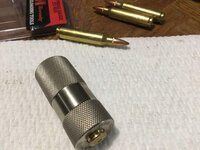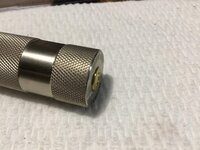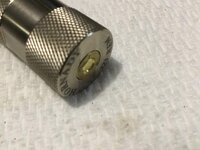- Messages
- 5,152
- Reactions
- 11,450
ive even removed live primers.
pondering pros/cons on such a project
Follow along with the video below to see how to install our site as a web app on your home screen.
Note: This feature may not be available in some browsers.
ive even removed live primers.
... If you're talking about rifle cartridges, the problem with resizing cases with live primers in place is removal of the case lube...




It seems to me that if the brass is ready to fire now, it has already been resized.....I would gently pull the bullets, charge and replace the bullets with what I wanted. It is easy to measure the ammo as it is to see if resizing is nessisary.I have some loaded 0.308 rounds I can't use (it's a kinda long story). However, if I could pull the bullets I could reload the primed brass.
I am wondering if I could remove the decapping pin from a resizing die and resize the brass again with the primer still in place. I am thinking the press would put some upward pressure on the base of the brass but it would be uniformly distributed. To me, it seems unlikely the primer would go off.
The primers are seating correctly. By that I mean they are deep enough so the surface of the primer is just below the surface of the head of the case.
Has anyone ever done this successfully, or is it just a totally crazing idea?
When dealing with primed cases, I've always used the lube pad method and motor mica for the necks. I don't clean the lube off until new bullets are seated. There is no ay any lub gts to the primer this way.
But then you have the issue of case lube on your work during the charging process...
Problem with using the chamber of your FA to check your sizing is twofold... For me at least. With an AR if the case is oversized, you run the risk of it sticking in the camber and upon extraction risk damaging charge handle and/or the extractor. Two not all chambers are equal. Some will work fine in one chamber, but stick in another. I've figured what will work in which best, but how the case fits in the case checker. I do try to fireform for my more precision FAs, but the batch in question is just a bulk batch of cheap 55grain I loaded for plinking. The case checker is invaluable now, because I can quickly sort through the batch and see what's what.
this is the batch I'm sorting...
View attachment 452535
If the case looks like this and I tried to put it in my Noveske Barrel with the early Mod0 chamber(notoriously tight chambers), I'd brake the charge handle before it extracted...
View attachment 452533
If it looks like this, it will stick in the tighter chambers, but will cycle fine in my sons PSA barrel. View attachment 452532
This is what they should look like....View attachment 452530
With the 300 blackout, you also have to make sure it doesn't go in too far...
This.I have done it without a hitch as well... I also have de-capped live primers... Slowly...with my head and body well away from the press.
Never had a problem, but weird bubblegum happens, so...
It seems to me that if the brass is ready to fire now, it has already been resized.....I would gently pull the bullets, charge and replace the bullets with what I wanted. It is easy to measure the ammo as it is to see if resizing is nessisary.
... Sometimes the sealant would act like glue and really cement the bullets into the necks. Sometimes it would be enough, just to use a bullet seater to gently push the bullet further down just a bit....in order to break that bond ...
Problem with using the chamber of your FA to check your sizing is twofold........
With the 300 blackout, you also have to make sure it doesn't go in too far...